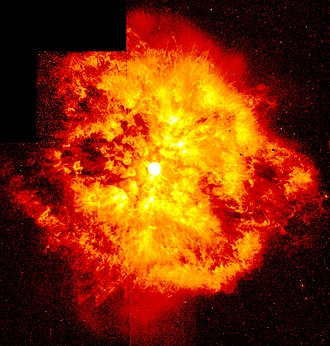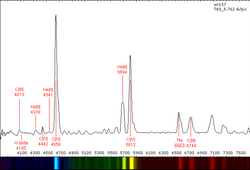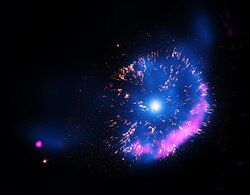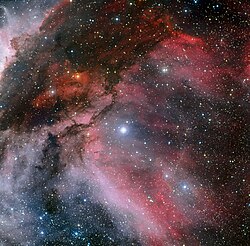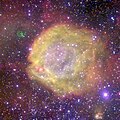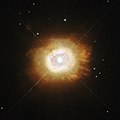Wolf–Rayet star
Wolf–Rayet stars (WR stars) are massive stars (over 20 solar masses initially). They are losing mass rapidly by means of a very strong stellar wind, with speeds up to 2000 km/s. While our own Sun loses about 10−14 solar masses every year, Wolf–Rayet stars typically lose 10−5 solar masses a year.[1] (The last number is one million times larger than the second-to-last number.)
Wolf–Rayet stars are extremely hot, with surface temperatures in the range of 30,000 K to around 200,000 K that make them look blue in color.[2] They are also highly luminous, from tens of thousands to several million times the bolometric luminosity of the Sun, although not exceptionally bright visually since most of their output is in far[clarification needed] ultraviolet and even "soft" X-rays.[3]
Clarification of terms
In astronomy, luminosity is not quite the same thing as brightness. Luminosity measures the total amount of energy emitted by a star or other astronomical object in SI units of joules per second, which are watts. A watt is one unit of power, and just as a light bulb is measured in watts, so is the Sun, which has a total power output of 3.846×1026 W. This number is the basic metric used in astronomy: it is known as 1 solar luminosity, the symbol for which is [math]\displaystyle{ L_\odot }[/math].
Radiant power, however, is not the only way to conceptualize brightness, so other metrics are also used. The most common is apparent magnitude, which is the perceived brightness of an object from an observer on Earth at visible wavelengths. Other metrics are absolute magnitude, which is an object's intrinsic brightness at visible wavelengths, irrespective of distance. The measure of luminosity is "bolometric magnitude", the total power output across all wavelengths.
Wolf–Rayet Star Media
James Webb Space Telescope image of the Wolf–Rayet star WR 124 and the nebula M1–67 surrounding it. NIRCam and MIRI composite.
WR 136, a WN6 star where the atmosphere shed during the red supergiant phase has been shocked by the hot, fast WR winds to form a visible bubble nebula
Spectrum of WR 137, a WC7 star and one of the three original WR stars (horizontal axis : wavelength in Å)
GK Persei (Nova Persei 1901), which showed Wolf–Rayet features in its spectrum
WR 22 in the Carina Nebula
Artist's illustration of gas disk around massive hydrogen-rich WR 122
AB7 produces one of the highest excitation nebulae in the Magellanic Clouds.
WR 31a is surrounded by a blue bubble created by a powerful stellar wind impacting material expelled during earlier stages of the star's life (ESA/Hubble & NASA Acknowledgement: Judy Schmidt)
HD 184738, also known as Campbell's star. This is actually a planetary nebula and the central star is an old low-mass star unlike the main class of massive Wolf–Rayet stars.
References
- ↑ Cannizzo J.K. 1998. "Ask an astrophysicist: Wolf-Rayet Stars". Nasa.gov.
- ↑ Sander A; Hamann W.R. & Todt H. 2012. The galactic WC stars. Astronomy & Astrophysics 540: A144. [1]
- ↑ X-rays with lower energy
